
|
Astronomy Picture Of the Day (APOD)
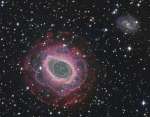 Ring Nebula Deep Field
Ring Nebula Deep Field
5.11.2009
A familiar sight to sky enthusiasts with even a small telescope, the Ring Nebula (M57) is some 2,000 light-years away in the musical constellation Lyra. The central ring is about one light-year across...
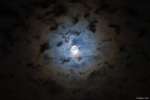 Halloween s Moon
Halloween s Moon
4.11.2009
Illuminating the landscape all through the night of November 2nd, this week's bright Full Moon was known in the northern hemisphere as a Hunter's Moon. But this dramatic view of the shining lunar orb, from Sobreda, Portugal, was captured just a few nights earlier, on Halloween.
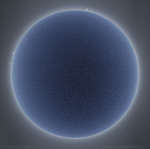 Blue Sun Bristling
Blue Sun Bristling
3.11.2009
Our Sun may look like all soft and fluffy, but it's not. Our Sun is an extremely large ball of bubbling hot gas, mostly hydrogen gas. The above picture...
 Seven Sisters Versus California
Seven Sisters Versus California
2.11.2009
On the upper right, dressed in blue, is the Pleiades. Also known as the Seven Sisters and M45, the Pleiades is one of the brightest and most easily visible open clusters on the sky. The Pleiades contains over 3,000 stars, is about 400 light years away, and only 13 light years across.
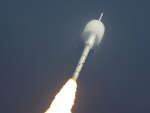 Ares 1 X Rocket Lifts Off
Ares 1 X Rocket Lifts Off
1.11.2009
Last week, NASA test fired a new rocket. The Ares 1-X was the first non-shuttle rocket launched from Kennedy Space Center since the Saturn launched humans to Earth orbit and the Moon in the 1960s and 1970s. NASA is testing Ares as a prelude to replacing the aging space shuttle fleet.
 The Average Color of the Universe
The Average Color of the Universe
31.10.2009
What color is the universe? More precisely, if the entire sky was smeared out, what color would the final mix be? This whimsical question came up when trying to determine what stars are commonplace in nearby galaxies. The answer, depicted above, is a conditionally perceived shade of beige.
 VdB 152: Reflection Nebula in Cepheus
VdB 152: Reflection Nebula in Cepheus
30.10.2009
Described as a "dusty curtain" or "ghostly apparition", mysterious reflection nebula VdB 152 really is very faint. Far from your neighborhood on this Halloween Night, the cosmic phantom is nearly 1,400 light-years away. Also cataloged as Ced 201, it lies along the northern Milky Way in the royal constellation Cepheus.
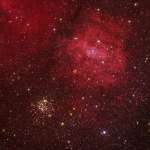 The Bubble and M52
The Bubble and M52
29.10.2009
To the eye, this cosmic composition nicely balances the Bubble Nebula at the upper right with open star cluster M52. The pair would be lopsided on other scales, though. Embedded in a complex...
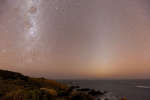 Zodiacal Light Over Laguna Verde
Zodiacal Light Over Laguna Verde
28.10.2009
An unusual triangle of light is visible this time of year just before dawn, in the northern hemisphere. Once considered a false dawn, this triangle of light is actually Zodiacal Light, light reflected from interplanetary dust particles.
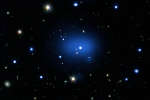 JKCS041: The Farthest Galaxy Cluster Yet Measured
JKCS041: The Farthest Galaxy Cluster Yet Measured
27.10.2009
What if we could see back to the beginning of the universe? We can -- since it takes the age of the universe for light to cross the universe. Peering at distant objects, therefore, tells us about how the universe used to be, even near its beginning.
|
January February March April May June July August September October November December |
|||||||||||||||||||||||||||||||||||||||||||||||||